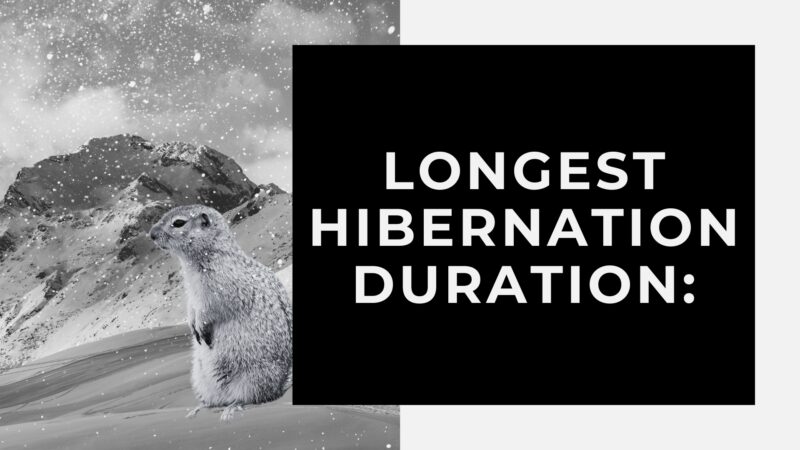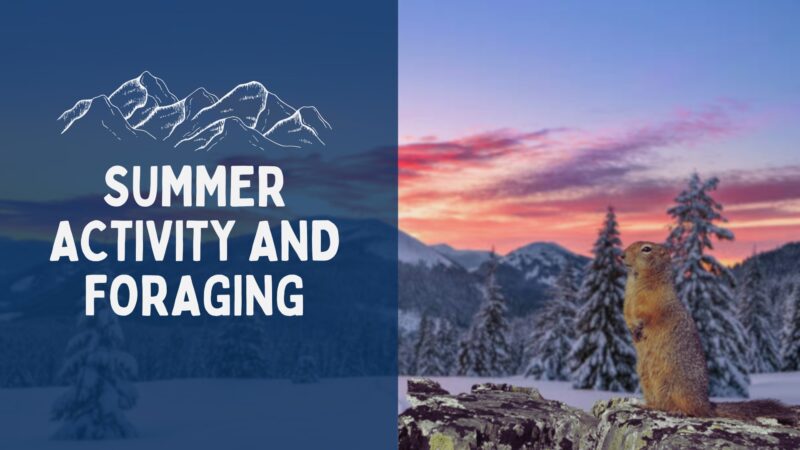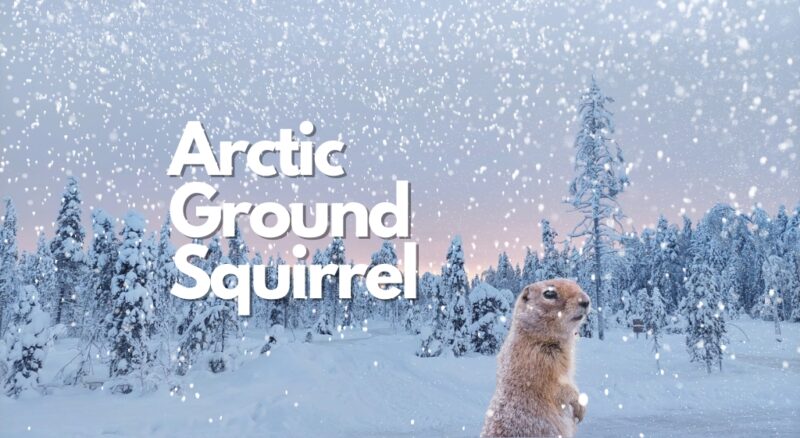In the vast and frigid landscapes of the Arctic, an extraordinary creature thrives with an astonishing adaptation – the Arctic Ground Squirrel. With a lifestyle perfectly attuned to withstand the harshest Arctic climate, this small rodent boasts the remarkable ability to endure the longest hibernation among all animals.
In this comprehensive blog post, we will explore the intriguing world of the Arctic Ground Squirrel, examining its unique characteristics, hibernation strategies, and its pivotal role in the Arctic ecosystem.
1. The Arctic Ground Squirrel’s Habitat and Distribution:
The Arctic Ground Squirrel (Spermophilus parry) is a member of the squirrel family Sciuridae, predominantly inhabiting the Arctic tundra regions of North America. These regions encompass Alaska, northern Canada, and parts of Siberia, where temperatures plummet to freezing levels during winter months.
While discussing fascinating wildlife in North America, we can’t overlook the remarkable creatures with a leisurely pace, as seen in the article about the slowest animals in North America.
Arctic Ground Squirrel’s Habitat and Distribution:
| Location | Habitat Description |
|---|---|
| Alaska | Tundra, meadows, and grasslands with sufficient ground cover |
| Northern Canada | Open areas near lakes, rivers, and streams |
| Siberia | Taiga and meadows with suitable burrow sites |
2. Physical Characteristics and Behavior:
The Arctic Ground Squirrel exhibits unique physical features and behaviors that enable it to thrive in extreme conditions. Measuring approximately 15 to 20 cm (6 to 8 inches) in length and weighing between 350 to 600 grams (0.77 to 1.3 lbs), these squirrels have round bodies with short legs and a bushy tail.
Physical Characteristics of Arctic Ground Squirrel:
| Characteristic | Description |
|---|---|
| Coat color | Mottled shades of brown and gray |
| Tail | Short and bushy, often with a white tip |
| Hibernation duration | Up to 7-9 months per year |
| Lifespan | Typically 3 to 5 years in the wild |
Arctic Ground Squirrels are diurnal creatures, active during the day, and have a communal social structure, living in colonies or “towns” that can house thousands of individuals.
3. The Remarkable Adaptation: Longest Hibernation Duration:

One of the Arctic Ground Squirrel’s most astonishing adaptations is its ability to undergo extended periods of hibernation. As temperatures plummet during the harsh Arctic winter, these squirrels enter a state of deep hibernation to conserve energy and survive the scarcity of food.
Hibernation Duration Comparison:
| Species | Hibernation Duration |
|---|---|
| Arctic Ground Squirrel | Up to 7-9 months per year |
| Other Ground Squirrels | 4-6 months |
| Bears | 4-6 months (depending on the species) |
| Hedgehogs | 3-5 months |
During hibernation, the Arctic Ground Squirrel’s body temperature drops significantly, allowing it to survive on stored fat reserves without the need to eat or drink. This remarkable adaptation helps the squirrel withstand the extreme cold and food scarcity during the long winter months.
4. Preparing for Hibernation: Gorging and Fat Accumulation:
To survive the extended hibernation period, Arctic Ground Squirrels undergo a crucial process known as “super fattening.” In the months leading up to hibernation, they voraciously feed on a wide range of food, including seeds, berries, insects, and vegetation.
Comparison of Pre-Hibernation Fat Accumulation:
| Species | Fat Accumulation Ratio in Body Weight |
|---|---|
| Arctic Ground Squirrel | Up to 50% |
| Black Bear | Up to 30% |
| Other Ground Squirrels | 15-20% |
| Other Rodents | 5-10% |
During this period, the squirrel can accumulate up to 50% of its body weight in fat, providing the essential energy stores required to endure the lengthy hibernation period.
5. The Hibernation Process and Torpor:
The Arctic Ground Squirrel’s hibernation process is a remarkable feat of survival. As the harsh Arctic winter sets in, the squirrel’s body temperature drops significantly, approaching the ambient temperature of its surroundings. This drop in body temperature is essential for conserving energy, as it dramatically reduces the squirrel’s metabolic rate, entering a state known as torpor.
During torpor, the Arctic Ground Squirrel enters a deep sleep-like state, slowing down all its bodily functions to an almost imperceptible level. Its heart rate and breathing drastically decrease, reaching levels of only a few beats per minute and a couple of breaths per hour, respectively. This state of extreme dormancy allows the squirrel to survive without food or water for the duration of its hibernation, which can last up to an astonishing 7 to 9 months per year, depending on local climate conditions.
While in torpor, the Arctic Ground Squirrel’s brain activity is also significantly reduced, with brain waves resembling those observed during deep sleep. This state of torpor serves as a crucial survival strategy to endure the extreme cold and food scarcity of the Arctic winter.
6. Importance in the Arctic Ecosystem:
The Arctic Ground Squirrel plays a vital role in the delicate balance of the Arctic ecosystem. As both prey and predator, they have a significant impact on the food chain within their habitat.
As prey animals, Arctic Ground Squirrels are an essential food source for various predators, including birds of prey like eagles, hawks, and owls, as well as terrestrial predators such as foxes and wolves. The squirrel’s high-fat content during hibernation makes it an attractive and nutritious meal for these carnivores when other food sources are scarce.
Conversely, Arctic Ground Squirrels also act as predators themselves. During the active summer months, they forage on a wide range of vegetation, including grasses, sedges, flowers, buds, and small insects. Their foraging habits have an impact on the distribution of plant species in their habitat and may influence the population dynamics of certain insect species.
In addition to their role in the food chain, Arctic Ground Squirrels also contribute to the ecosystem through their burrowing activities.
7. Summer Activity and Foraging:

| Foraging Behavior | Food Source |
|---|---|
| Grasses and Sedges | Nutrient-rich grasses and sedges |
| Flowers and Buds | Nectar, pollen, and buds from flowering plants |
| Insects | Caterpillars, beetles, grasshoppers, and more |
As temperatures rise and the Arctic landscape briefly thaws during the short summer months, the Arctic Ground Squirrel emerges from its lengthy hibernation. The transition from torpor to activity is gradual, allowing the squirrel to conserve energy as it acclimatizes to the changing environment.
Once active, Arctic Ground Squirrels engage in various behaviors to maximize their chances of survival and reproduction. One of their primary activities is foraging for food. They are opportunistic eaters and have a diverse diet, feeding on a variety of plants and insects available in their habitat.
Curious about the diverse squirrel vocalizations from barks to whistles? Learn more about these fascinating sounds
Grasses, sedges, flowers, and buds are staples of their diet, providing essential nutrients for their survival. Additionally, they prey on insects like caterpillars, beetles, and grasshoppers, supplementing their diet with valuable protein during the short summer season.
8. Burrowing and Shelter:
To protect themselves from predators, and extreme weather, and to provide a safe environment for rearing their young, Arctic Ground Squirrels are adept at creating elaborate burrows.
These burrows are not merely simple holes in the ground; they are complex networks of tunnels with multiple entrances and chambers. The main burrow extends several meters below the surface, providing the squirrel with a retreat during harsh weather conditions and potential threats from predators.
Arctic Ground Squirrels exhibit intelligence in constructing their burrows, placing entrances strategically to maximize sunlight exposure and minimize the chances of predators sneaking up on them. They are also known to create separate chambers for specific purposes, such as nesting, storing food, and even “bathrooms” to keep their living areas clean.
9. Social Structure and Communication:
Arctic Ground Squirrels exhibit interesting social behaviors within their colonies. They are highly gregarious creatures and often live in large, interconnected communities known as colonies or “towns.”
Within the colony, individual squirrels communicate with each other using a combination of vocalizations and body language. They have a range of alarm calls to alert other members of the colony to potential threats. Different calls are used to distinguish between aerial predators, like birds of prey, and ground-based threats, such as foxes or other terrestrial predators.
The social structure of the colony is complex, with dominant individuals asserting control over certain areas or resources. Subordinate squirrels may engage in submissive behaviors to avoid conflicts and maintain harmony within the community.
10. Reproduction and Family Life:
The Arctic Ground Squirrel’s breeding season begins shortly after emerging from hibernation, usually in early spring. Mating occurs during this period, and females give birth to litters of 5 to 10 pups, typically in late spring or early summer.
Female squirrels invest significant effort in nurturing and protecting their young. The pups are born blind and hairless, relying solely on their mother’s care for survival. The mother provides milk for her offspring, ensuring their rapid growth and development.
In the early weeks of their lives, the mother keeps the pups warm and safe within the burrow, rarely leaving their side. As they grow, she teaches them essential survival skills, such as foraging for food and identifying potential threats.
The bond between mother and offspring is strong, and the female remains devoted to her young until they are old enough to venture out of the burrow and fend for themselves.
FAQs
How does the Arctic Ground Squirrel’s hibernation compare to other animals?
The Arctic Ground Squirrel’s hibernation duration surpasses that of other ground squirrels, bears, and hedgehogs, making it the hibernation champion of the animal kingdom.
What are some unique behaviors and characteristics of the Arctic Ground Squirrel?
The Arctic Ground Squirrel exhibits diurnal behavior, living in communal colonies, and undergoes “super fattening” to prepare for hibernation. Its burrowing activities and communication within the colony are also remarkable.
Why are Arctic Ground Squirrels referred to as “pint-sized heroes” in the Arctic?
Arctic Ground Squirrels are considered pint-sized heroes due to their remarkable adaptation to survive the harsh Arctic climate, especially their ability to hibernate for an extended period and endure extreme conditions.
How do researchers and wildlife enthusiasts view the Arctic Ground Squirrel?
Researchers and wildlife enthusiasts are captivated by the Arctic Ground Squirrel’s unique characteristics, hibernation strategies, and significant role in maintaining the delicate balance of the Arctic ecosystem.
Conclusion:
In the freezing expanse of the Arctic, there’s a pint-sized hero that defies all odds – the Arctic Ground Squirrel! These adorable rodents have honed their survival skills to masterful levels, making them true champions of the frozen north. From their awe-inspiring hibernation prowess to their vital role in the Arctic ecosystem, they have become the stars of the wilderness, captivating researchers and wildlife enthusiasts alike.
Imagine snoozing for an entire winter – the stuff of dreams, right? Well, for the Arctic Ground Squirrel, it’s a reality! As temperatures plunge, they tuck themselves into their cozy burrows and enter a deep slumber called torpor. Their metabolic rate drops to superhero-level lows, conserving energy like no other. They’re like the hibernation champions of the animal kingdom, snatching the crown for the longest snooze of all!








